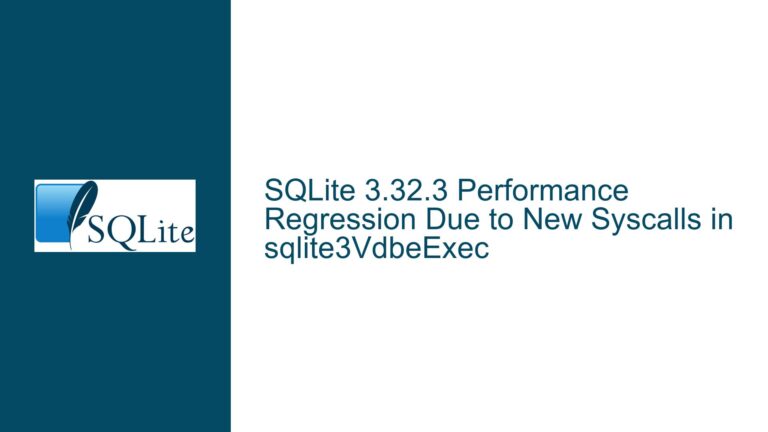Approximate COUNT(*) in SQLite Using sqlite_stat4 and sqlite_stat1
SQLite’s Full Table Scan for COUNT(*) and the Need for Approximations
SQLite is widely used as an open data publication format, particularly in projects like Datasette, where users frequently perform summary explorations of data. One of the most common operations in such explorations is the COUNT(*) query, which returns the total number of rows in a table. However, SQLite always performs a full table scan to resolve a COUNT(*) query, which can be prohibitively expensive and slow, especially for large datasets. This behavior is a significant bottleneck in scenarios where quick, approximate results are acceptable, and exact counts are not strictly necessary.
SQLite already has mechanisms to gather and store statistics about tables and indices through the ANALYZE command. These statistics are stored in the sqlite_stat1 and sqlite_stat4 tables. The sqlite_stat1 table contains basic statistics, such as the number of rows in a table and the distribution of values in indexed columns. The sqlite_stat4 table provides more detailed information, including histograms of indexed column values. Given that ANALYZE is often run in data publishing scenarios, these statistics are typically up-to-date and could be leveraged to provide approximate row counts without the need for a full table scan.
The core issue is that SQLite does not currently provide a built-in mechanism to use these statistics for approximate COUNT(*) queries. This limitation forces users to either endure the performance hit of a full table scan or implement custom solutions to estimate row counts. The discussion revolves around the feasibility of adding a PRAGMA approximate_count feature that would allow SQLite to return approximate counts based on the statistics stored in sqlite_stat1 and sqlite_stat4.
Interrupted Write Operations Leading to Index Corruption
The need for approximate counts is particularly acute in scenarios where performance is critical, and the data is static or changes infrequently. In such cases, the statistics gathered by ANALYZE are reliable and can be used to estimate row counts with a high degree of accuracy. However, the current implementation of SQLite does not expose these statistics in a way that can be easily used for this purpose.
One of the challenges in implementing an approximate count feature is ensuring that the estimates are accurate enough to be useful. The sqlite_stat1 table stores the total number of rows in a table, but this information is only accurate at the time ANALYZE was run. If the table has been modified since then, the row count in sqlite_stat1 may be outdated. The sqlite_stat4 table provides more detailed information, but it is primarily designed for query optimization and does not directly provide a mechanism for estimating row counts.
Another challenge is that the statistics in sqlite_stat1 and sqlite_stat4 are not designed to handle complex queries. For example, if a query includes a WHERE clause that filters rows based on a condition, the statistics may not provide enough information to estimate the number of rows that match the condition. This limitation means that any approximate count feature would need to be carefully designed to handle a wide range of query types.
Implementing PRAGMA journal_mode and Database Backup
To address the need for approximate counts in SQLite, several approaches can be considered. One approach is to implement a new PRAGMA approximate_count feature that would allow SQLite to return approximate counts based on the statistics stored in sqlite_stat1 and sqlite_stat4. This feature would be particularly useful in scenarios where performance is critical, and exact counts are not required.
The implementation of such a feature would involve modifying the SQLite source code to add a new PRAGMA command that retrieves the row count from sqlite_stat1 and returns it as an approximate count. This approach would be relatively straightforward to implement, but it would only provide approximate counts for simple COUNT(*) queries without any filtering conditions.
For more complex queries, a more sophisticated approach would be needed. One possibility is to extend the sqlite_stat4 table to include additional information that can be used to estimate the number of rows that match a given condition. This would require significant changes to the SQLite query planner and optimizer, but it would provide a more general solution that could handle a wider range of query types.
Another approach is to use the DBSTAT virtual table, which provides detailed information about the structure of the database file, including the number of leaf pages in each table. By counting the number of leaf pages and using a sample to estimate the average number of rows per leaf page, it is possible to estimate the total number of rows in a table. This approach is more complex and requires a deeper understanding of SQLite’s internal data structures, but it can provide more accurate estimates for large tables.
In addition to these approaches, it is also important to consider the impact of database modifications on the accuracy of approximate counts. If a table is frequently updated, the statistics in sqlite_stat1 and sqlite_stat4 may become outdated, leading to inaccurate estimates. To address this issue, it may be necessary to periodically re-run ANALYZE to update the statistics. Alternatively, the approximate count feature could include a mechanism to automatically update the statistics when they become too outdated.
Finally, it is worth noting that the SQLite development team has already experimented with an est_count feature, which was designed to speed up ANALYZE for large databases. This feature was eventually folded into the PRAGMA analyze_limit command, which limits the number of rows analyzed by ANALYZE. While this feature is not directly accessible to application code, it provides a foundation for future development of approximate count functionality.
In conclusion, the need for approximate counts in SQLite is a significant issue that affects the performance of data exploration and analysis tasks. While SQLite currently does not provide a built-in mechanism for approximate counts, there are several potential approaches to address this issue, including the implementation of a new PRAGMA approximate_count feature, extending the sqlite_stat4 table, and using the DBSTAT virtual table. Each of these approaches has its own advantages and challenges, and the best solution will depend on the specific requirements of the application. By carefully considering these options and implementing the appropriate changes, it is possible to significantly improve the performance of COUNT(*) queries in SQLite.






